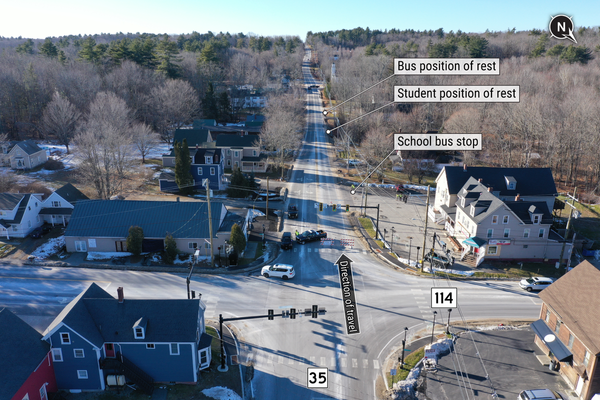On February 18, the Supreme Court agreed to review whether the Biden administration’s ending of the Migrant Protection Protocols was legal. The policy, otherwise known as Remain in Mexico, requires people fleeing persecution who arrive at the southern US land border to wait in Mexico as they wait for their immigration hearing. It only applies to people from countries other than Mexico.
Beginning under the Trump administration in January 2019, the program was a change from the previous policy of allowing migrants seeking protection to stay in the United States while awaiting immigration proceedings.
A federal district appeals court ruled in August 2021 that the policy must remain in place. According to new data released in February, 673 people have enrolled in the Migrant Protection Protocols since it was restarted.
About 56,000 people were subject to the Remain in Mexico policy in 2019. The number of applicants for defensive asylum – one of the primary methods of relief for Remain in Mexico enrollees – in 2019 was about 211,000, up from 163,000 in 2018. About 19,000 defensive asylum claims were granted in 2019.
Why was the program terminated and why did it have to restart?
Shortly after taking office, President Joe Biden ordered the Department of Homeland Security (DHS) to review the Migrant Protection Protocols and determine whether to terminate or modify the program. DHS Secretary Alejandro Mayorkas subsequently issued an explanation of the review of the protocols and of his decision to terminate the program.
Secretary Mayorkas said while the program likely contributed to fewer migrants, the “substantial and unjustifiable human costs” some migrants experienced in Mexico outweighed the benefits. The Biden administration announced that it would begin to transfer enrollees to the US to complete their immigration proceedings.[1]
The state of Texas sued the administration over the end of the program, claiming that DHS had violated the Administrative Procedure Act by failing to consider important factors in its decision.
Texas cited an agreement DHS made in December 2020 to consult with the state before taking any action to reduce immigration enforcement. It also claimed that allowing migrants to enter the US while awaiting immigration proceedings is a violation of federal law.
A district court ruled in Texas’ favor, requiring DHS to reimplement the Remain in Mexico program or take new action to comply with relevant laws. A federal appeals court later upheld this ruling. The Supreme Court declined the Biden administration’s request to block the lower courts’ injunction. The Supreme Court has since accepted the administration’s request for a judicial review of the appeal court’s decision.
How many people are enrolled in the Remain in Mexico program?
As of February 7, 69,371 people had enrolled in the policy since it began in 2019. The majority – 81% – of these enrollments happened in the program’s first year.
Even at its peak, the number of people returned to Mexico by Customs and Border Protection under the program was a fraction of the other immigrants denied entry into the US. In 2019, about 56,000 people were enrolled in the Remain in Mexico program, while there were about 922,000 immigration encounters at the southwest border.
In the same year, about 76,000 of a total 2.5 million new immigrants were admitted to the US as refugees or asylees.
Detailed government data is not yet available about the demographics of enrollees, although a federal records clearinghouse at Syracuse University compiled information from court records to shed light on details about these cases.
People from Honduras, Guatemala, and El Salvador are the largest groups of non-Mexican immigrants encountered at the southern land border denied entry into the US since the program’s inception.
What happens to immigrants who were enrolled in the Remain in Mexico program?
Immigrants enrolled in the program are scheduled for a removal proceeding at a designated port of entry, where they will make their case to an immigration judge for protection. Immigrants in the program must remain in Mexico until the date and time of their hearing and throughout the duration of their immigration proceedings.
Comprehensive data for the outcomes of these cases is not yet publicly available. A December 2020 DHS report indicates that at the end of 2020, 64.7% of Remain in Mexico cases had been completed, with 0.8% resulting in a grant of relief through asylum or withholding of removal. This represents 531 people who were granted relief by December 2020.
Some enrollees are later apprehended trying to enter the US somewhere other than an official port of entry. Since January 2020, an average of 301 people per month were caught trying to enter the US after being returned to Mexico through the program.
[1] Secretary Mayorkas's full quote from his explanation of his decision to terminate the program is: "I have determined that MPP should be terminated. In reaching this conclusion, I recognize that MPP likely contributed to reduced migratory flows. But it did so by imposing substantial and unjustifiable human costs on the individuals who were exposed to harm while waiting in Mexico…Significant evidence indicates that individuals awaiting their court hearings in Mexico under MPP were subject to extreme violence and insecurity at the hands of transnational criminal organizations that profited by exploiting migrants’ vulnerabilities."







